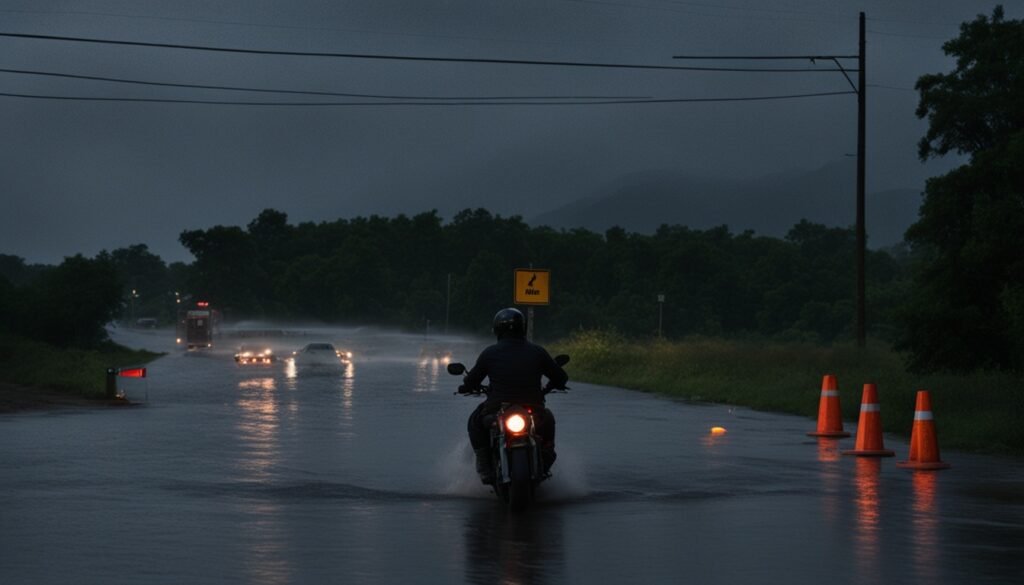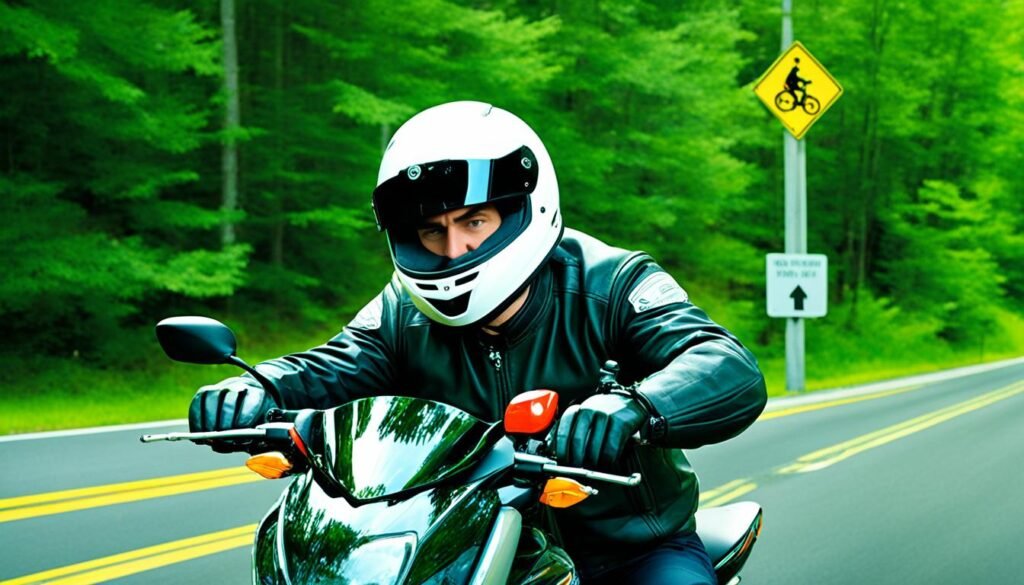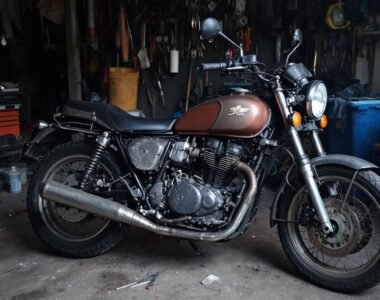
Riding a motorcycle is thrilling and freeing, but it has its own set of challenges and safety tips. Not everyone is ready for the demands of riding a bike. This article looks at key factors to think about before deciding if riding a motorcycle is right for you. These include your physical and mental health, your skills with machines, and how aware you are of your surroundings.
Key Takeaways
- Motorcycle riding needs a lot of physical and mental fitness, plus special skills and knowledge.
- Your ability to ride safely can be affected by your vision, coordination, balance, and interest in mechanics.
- Being aware of your surroundings, managing risks, and knowing how to handle emergencies are key for riders.
- Bad weather, riding while impaired, and not having enough experience can make riding a motorcycle much riskier.
- Getting the right training and education is key to riding safely and responsibly.
Introduction: Understanding the Risks of Motorcycle Riding
Riding a motorcycle is thrilling but also risky. Before you start, think about your physical, mental, and safety skills. It’s key to know the challenges and safety tips of riding to decide if it’s right for you.
Importance of Self-Assessment for Potential Motorcycle Riders
Motorcycling isn’t for everyone. It needs special skills, physical strength, and a focus on safety. Potential riders should check if they’re okay with the risks, can handle the bike, and stay alert. This check is vital for motorcycle safety.
Exploring the Unique Challenges and Safety Considerations of Motorcycle Operation
Motorcycles have their own set of challenges. They’re less stable, more exposed, and require more attention and risk assessment and situational awareness. Riders must put safety first, for themselves and others.
“Riding a motorcycle is not for the faint of heart. It requires a level of skill, focus, and responsibility that not everyone possesses.” – Renowned Motorcycle Safety Expert
Knowing the risks and challenges of riding helps you decide if it’s right for you. Self-checking and focusing on safety are key for a good and safe ride.
Physical and Mental Capabilities Required for Safe Motorcycle Riding
Riding a motorcycle safely needs certain physical and mental skills. Riders must have good coordination and balance. They also need to see and react to dangers on the road. Plus, avoiding risky driving habits is key to staying safe.
Risk-taking Tendencies and Aggressive Driving Behaviors
The Motorcycle Safety Foundation (MSF) says not everyone is cut out for motorcycling. They highlight the need for skills and judgment for safe riding. Risky behavior is a big concern, as it can lead to accidents.
Coordination and Balance Skills: Riding a Bicycle as a Prerequisite
To start the Basic RiderCourse, you must know how to ride a bike. This shows how important balance and coordination are for motorcycle training. It’s a basic skill needed to ride safely.
Vision and Perceptual Abilities Crucial for Hazard Detection
Good vision is key for safe motorcycle riding, says MSF. Riders must see and react to dangers quickly. This helps keep them and others safe on the road.
| Physical Capabilities | Mental Skills |
|---|---|
|
|
Safe motorcycle riding needs both physical and mental skills. Riders must be able to control the bike with coordination, balance, and good vision. They also need to think clearly to spot and avoid dangers. It’s important for riders to check themselves and get the right training for a safe ride.
Mechanical Inclination and Safety-Mindedness
Riding a motorcycle is more than just loving the open road. It’s about knowing your bike well and always putting safety first. As a rider, it’s crucial to have a good understanding of your motorcycle and to always think about safety.
Understanding Basic Motorcycle Maintenance and Inspections
Keeping your motorcycle in great shape is key to staying safe and making the most of your bike. Learn the basics of motorcycle maintenance, like regular checks and fixing small problems. Knowing how your bike works helps you spot and fix issues early.
Respecting Machinery and Adhering to Safety Protocols
Motorcycles are powerful and need to be treated with respect. Appreciate the engineering and skill that went into making your bike. Always follow safety rules, like wearing the right gear, riding safely, and being aware of your surroundings.
| Statistic | Value |
|---|---|
| Motorcyclists are 17 times more likely to be involved in accidents compared to passenger car drivers | 4 |
| Over 50% of road accidents in Malaysia involve motorcyclists | 5 |
| Malaysia has the highest road fatality risk among the ASEAN countries, with more than 50% of road accident fatalities involving motorcyclists | 5 |
| The most influential factor contributing to motorcycle crashes in Malaysia is human behavior | 9 |
| An analysis by McCartt et al. suggested that crash rates among motorcyclists are more strongly related to age than to years of licensure | 10 |
Building a strong mechanical aptitude and sticking to safety protocols makes riding better and safer for everyone. Remember, good motorcycle maintenance and being safety-aware are key to being a skilled rider.
“Respect for the machine and a willingness to adhere to safety protocols are essential for minimizing risks on the road.”
When should you not ride a motorcycle?
Riding a motorcycle is thrilling and freeing, but it’s also risky. Riders must think about when it’s best to stay off the bike. Key things to remember are lack of focus and situational awareness, and not being able to handle emergencies or dodge obstacles.
Lack of Focus and Situational Awareness
Motorcycle riding needs your full attention always. If you’re distracted or tired, it’s best to wait. You must be sharp and aware of what’s around you to stay safe.
Inability to Handle Emergencies or Perform Evasive Maneuvers
Motorcycles are harder to handle than cars, especially in emergencies. If you can’t quickly react or dodge obstacles, it’s risky. You need good training and practice before riding.
Deciding to ride a motorcycle means thinking about your skills and the situation. Knowing your limits and being cautious helps ensure a safe and fun ride.

Adverse Weather Conditions and Motorcycle Safety
Riding a motorcycle in bad weather like rain, fog, or ice is very dangerous. These conditions can make it hard to keep your bike stable and see the road. This increases the risk of accidents and makes it tough to control your motorcycle.
Riding in Rain, Fog, or Icy Conditions
Motorcycles are less likely to hydroplane than cars because of their round tires. But, roads can be slippery right after a dry spell because of dirt and oil. Rain can make it hard to see clearly because of the raindrops on your visor.
Be careful on wet roads because some spots are extra slippery. Look out for things like bitumen repair stripes and plastic arrows. They can make accidents more likely.
Reduced Traction and Visibility as Potential Hazards
In heavy storms, relax your muscles to keep your motorcycle steady. The flapping knee technique helps you ride straight and fight against strong winds. In mist, check your mirrors often to see what’s behind you.
Riding in mist can make it hard to see because of all the droplets on your visor. Use special gloves or a chamois to keep your vision clear. Yellow glasses can help you see better in mist, especially if it’s freezing and your visor might freeze over.
Rain and snow make roads slippery, making it hard to control your motorcycle. In the cold, tires get stiff and don’t grip the road well. In the heat, your engine might overheat and cause an accident.
Strong winds can make big motorcycles wobble. You need to pay close attention and control your bike well.
| Weather Condition | Potential Hazards | Recommended Precautions |
|---|---|---|
| Rain | Reduced traction, hydroplaning, poor visibility | Reduce speed, maintain proper following distance, use caution on slippery surfaces |
| Fog | Severely reduced visibility, difficulty seeing other vehicles | Slow down, increase following distance, use fog lights, be alert for other road users |
| Ice | Extremely low traction, lack of control | Avoid riding if possible, use extreme caution if necessary, maintain low speeds |
Try to avoid riding in bad weather if you can. The risk of accidents and losing control is high. If you must ride, be extra careful, adjust how you ride, and make sure your bike is ready to minimize the dangers.
Impaired Riding: Alcohol, Drugs, and Fatigue
Riding a motorcycle is exciting but comes with big responsibilities. When you ride, you need to stay sharp to keep yourself and others safe. Sadly, many riders risk their safety by riding under the influence of alcohol, drugs, or when they’re very tired.
The Dangers of Riding Under the Influence
Being impaired while riding can lead to serious accidents. Even a little alcohol can make you less aware and slower to react. Drugs can also mess with your judgment, making it harder to ride safely.
In NSW, about one in seven crashes where someone dies is because of impaired riding. To stop these tragedies, NSW has strict rules about alcohol levels for drivers. These rules vary from zero for new riders to 0.05 for most others.
Fatigue and Its Impact on Reaction Time and Decision-Making
Tiredness is a big danger for motorcycle riders. It slows down your reactions and clouds your judgment. It’s important to take breaks while riding. Research shows that riders can travel 44 meters in just 2 seconds if they’re tired or distracted.
Riders need to look out for their safety and others’. Avoiding alcohol, drugs, and riding when tired can greatly lower the risks. This way, you can make sure your ride is safer for everyone.
“It’s impossible to calculate your BAC accurately as it may continue to rise for up to two hours after you stop drinking.”
Night Riding and Visibility Concerns
Riding a motorcycle at night is challenging and risky. It’s harder to see hazards and be seen by others, making accidents more likely. Using the right lights and reflective gear is key to making your bike more visible and keeping you safe at night.
Reduced Visibility and Increased Risk of Collisions
In 2016, 47% of fatal motorcycle crashes happened at night, between 9 pm and 3 am. Nighttime riding caused 27% of motorcycle deaths that year, says the IIHS. Fatalities were almost twice as common on weekends as on weekdays.
Importance of Proper Lighting and Reflective Gear
Motorcyclists need to make themselves more visible to stay safe at night. Wearing bright clothes like neon or white can help. LED lights, brake light flashers, and high beams also make your bike stand out.
Riding near other cars’ headlights helps you see the road better. Wearing yellow-tinted glasses or photochromic visors can also help in low light. The NHTSA says 37% of motorcycle injuries happen at night, even though most riding isn’t at night.
It’s important to ride slower and keep a safe distance at night. Wearing bright or reflective clothes and gear can help others see you. This can lower the risk of accidents caused by others not seeing you.
“Riding a motorcycle at night requires extra precautions to ensure your safety. Proper lighting and reflective gear can make all the difference in being seen and avoiding collisions.”
Passenger Safety and Motorcycle Riding
When you ride a motorcycle with passengers, you need to think about safety more. Having a passenger changes how the bike handles and moves. This can make accidents more likely. Riders should check if they’re good enough and if the bike can handle passengers safely.
Considerations for Carrying Passengers
Make sure the motorcycle’s weight is spread out evenly when you have passengers. This keeps the bike stable and prevents it from tipping. Everyone should wear helmets, gloves, jackets, and pants to stay safe.
Before you start riding, talk about how to get on and off, where to sit, and what to do in emergencies. It’s important for the rider and passenger to talk clearly about things like stopping or seeing hazards.
Potential Increased Risk and Reduced Maneuverability
Having passengers makes riding riskier because of the extra weight and how hard it is to move the bike. Riders need to be good at controlling speed, brakes, and turns. The passenger should tell the rider if they need to slow down or stop. They should sit easy to help balance the bike.
Before you go out, make sure the bike is ready for the extra weight. This means checking the shocks, suspension, and tire pressure. The rider is key to keeping the passenger safe, comfortable, and guided.
| Riding with Passengers | Riding Alone |
|---|---|
| Increased risk of accidents due to added weight and reduced maneuverability | Lower risk of accidents with fewer variables to consider |
| Requires smooth acceleration, braking, and turning to ensure passenger safety and comfort | Allows for greater agility and control of the motorcycle |
| Necessitates adjustments to the motorcycle’s suspension, shocks, and tire pressure | No need for additional adjustments to accommodate extra weight |
| Clear communication and cooperation between rider and passenger is crucial | Rider has full control and decision-making authority |

Riding a motorcycle is thrilling, but with passengers, you need to be extra careful. Make sure you’re skilled enough, your bike is set up right, and you talk well with your passenger. This way, you can have a safe and fun ride.
Inexperience and the Need for Proper Training
Riding a motorcycle is thrilling but risky, especially for beginners. If you’re new to riding, think carefully about whether it’s right for you. Taking a motorcycle rider course is key to learning the skills and gaining confidence you need.
Trying to ride a motorcycle without training increases your risk of accidents. The Motorcycle Safety Foundation Course teaches new riders the basics like clutch control and braking. Track days and schools like the Yamaha Champions Riding School offer coaching for all levels, focusing on safety and technique.
The Importance of Formal Motorcycle Rider Courses
For inexperienced riders, formal courses are vital. They teach you how to operate a motorcycle safely. You’ll learn about:
- Proper clutch control and gear shifting
- Effective braking techniques
- Handling and maneuvering the motorcycle
- Hazard identification and avoidance
These courses give you the skills and confidence you need to ride safely. This reduces the risk of accidents and injuries.
Building Skills and Confidence Before Hitting the Road
Getting good at riding takes time and practice. Start with a motorcycle training course and gradually increase your experience. Look for rider courses and guided practice sessions in your area.
Books like “Twist of the Wrist” and “Total Control” offer insights into motorcycle physics and riding techniques. Riding with experienced riders can also help you improve by learning from their safe practices.
Preparing and training before you ride can greatly improve your safety and enjoyment.
Legal Requirements and Regulations for Motorcycle Riders
As a responsible motorcycle rider in Australia, knowing the legal rules is key. These rules help keep you and others safe on the road. It’s important to follow them to avoid legal trouble and stay safe.
Licensing and Registration Requirements
You need the right license to ride a motorcycle legally. The type of license depends on your bike’s engine size and class. Also, you must register your motorcycle with the authorities. Not doing so can lead to big fines and legal issues.
Helmet Laws and Safety Gear Mandates
In most places, wearing a helmet is a must for motorcycle riders. This law aims to reduce head injuries in crashes. You might also need to wear gloves, strong clothes, and reflective gear to be seen and stay safe.
If you don’t follow these safety gear rules, you could face big fines and get demerit points on your license.
| Regulation | Penalty |
|---|---|
| Failure to wear an approved helmet | $341.00 fine and 3 demerit points |
| Subsequent helmet offense within 12 months | Double demerit points |
| Violation of lane filtering rules | $341.00 fine and 3 demerit points |
| Failure to comply with new motorcycle control laws | $151.00 fine |
Learning about motorcycle laws in Australia helps you ride legally and safely. This way, you avoid fines and help make the roads safer for everyone.
Conclusion
Riding a motorcycle is thrilling but also risky. Before you start, think about your physical, mental, and safety skills. Also, consider the environment and laws. This helps you make smart choices and ride safely.
Many fatal motorcycle crashes happen because of speeding, drinking, not having a license, or being too young. It shows how important it is to assess the risks before you ride. Be honest about your abilities. Don’t ride if you’re not fully focused or safe.
Deciding when not to ride should be based on your skills, the conditions, and the risks. Putting safety first and making wise choices lets motorcyclists in Australia enjoy their rides safely. Being proactive with motorcycle safety helps riders feel confident and safe on the road.
FAQ
When should you not ride a motorcycle?
Don’t ride a motorcycle if you find it hard to stay focused and aware of your surroundings. Also, if you’re not skilled in handling emergencies or if your physical or mental abilities make it unsafe.
What are the unique challenges and safety considerations of motorcycle riding?
Riding a motorcycle requires certain skills and abilities. You need good coordination, balance, and the ability to see and react to dangers. It’s also important to think carefully about your risk-taking and to keep your motorcycle in good condition.
What physical and mental capabilities are required for safe motorcycle riding?
To ride a motorcycle safely, you need to be coordinated and balanced. You must also be able to see and react to dangers on the road. Avoid driving aggressively to lower your accident risk.
Why is mechanical inclination and safety-mindedness important for motorcycle riders?
Riders should know how to do basic maintenance and checks on their bikes. This keeps them safe. Also, respecting your bike and following safety rules helps reduce risks.
What factors indicate when someone should not ride a motorcycle?
If you can’t focus well or handle emergencies, don’t ride a motorcycle. It’s also risky if you’re not skilled in avoiding dangers.
How can adverse weather conditions affect motorcycle safety?
Bad weather like rain or ice can make it hard to control your bike. It also lowers visibility, making accidents more likely. Think carefully before riding in bad weather.
What are the dangers of riding a motorcycle while impaired?
Riding a motorcycle while drunk or on drugs is very dangerous. It slows down your reactions and judgment. Always be careful and avoid riding if you’re under the influence.
What unique challenges come with riding a motorcycle at night?
At night, it’s harder to see dangers and be seen by others. Use good lights and wear reflective gear to stay safe.
What considerations should be made when carrying passengers on a motorcycle?
Carrying passengers can make your bike harder to control. Make sure you’re skilled enough and your bike is right for it. Always follow safety steps when riding with passengers.
Why is proper training and experience important for motorcycle riders?
Taking a motorcycle course teaches you important skills and builds your confidence. Trying to learn without training increases your risk of accidents.
What legal requirements do motorcycle riders need to be aware of?
Riders must follow the law by getting the right licenses and registering their bikes. Some places require helmets and other safety gear. Knowing and following these rules is key to riding safely and legally.



